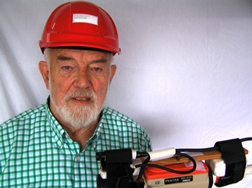 How are seismic waves transmitted to buildings? David Cox* investigates the implications of two different views.
How are seismic waves transmitted to buildings? David Cox* investigates the implications of two different views.
There is some uncertainty in assessing seismic motion for structural design. One school believes the ground moves as a large consistent mass leaving a uniform 'permanent ground deformation' (PGD), with no local 'differential ground deformation' (DGD) . Acceleration of the ground mass and transmission to the structure is the basis for structural design. A fluid model would be a long-wavelength sea-swell, and a mechanical model something like 'Newton's Cradle' (a series of pendulum balls where only the first and last move).
An alternative proposition is that the ground moves differentially both horizontally and vertically (referred to as 'DGD' or 'asynchronous motion' or 'transient ground deformation'). The design basis is then not only the acceleration, but also horizontal extension and compression, and vertical differential deflections across the structure, causing 'racking' or twisting of walls and floors. A fluid model would be a choppy sea with local peaks where waves intersect. A mechanical model would be something like a four-legged table wobbling and deforming on irregular ground.
Design
Which type of motion predominates is important for design. Simplistically, a strong rigid structure would resist acceleration, but a flexible ductile structure would survive DGD. The extent of DGD is unresolved. Measurement is hindered by accelerometers, which require considerable integration to determine deflection, and GPS devices with digital delay, neither of which are commonly sited in the closely spaced arrays required to measure DGD. CCTV records, or local changes in known road levels might be used, but accuracy is then a problem.
Surveys of damaged areas show total PGD but not peak dynamic values, or differentials within the structural footprint. Static design is similar. We can predict total settlement of a structure but it is differential settlement that causes deformation and damage. Post-seismic damage surveys suggest lots of racking / twisting of structures that might be due to acceleration forces, but could also be due to DGD.
Damage
Seismic damage can be similar to mining subsidence or clay shrink/swell damage, with additional acceleration effects. Damage often varies widely between adjacent similar structures, tending to suggest the 'choppy sea' model of intersecting waves causing local differential motion. Services are often badly damaged. This cannot be due to acceleration, but rather, DGD.
Models such as shaking tables, which replicate only acceleration, re-create structural effects such as toppling and resonance, but not the differential motion which causes 'racking' and diagonal cracks, nor the stretching that damages otherwise flexible services.
Nuclear stations
The UK is to build six nuclear power stations(NPS) using designs based on the acceleration during the UK's most damaging earthquake, in 1884 (between Bradwell and Colchester in Essex , coincidentally where one of the six NPS is to be sited). The Bradwell NPS construction is to be by Chinese companies who have a sincere interest in earthquake-proof research and design. Many of the residual problems at Fukushima are due to buried structures and pipes leaking, probably because of DGD rather than acceleration damage.
More research seems to be indicated for seismic design!
*Dr David Cox MICE FGS CEng is an Independent Consulting Engineer E: [email protected]